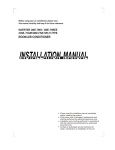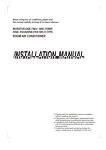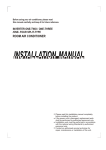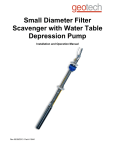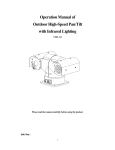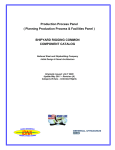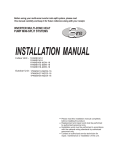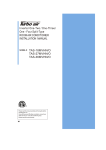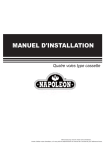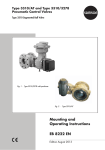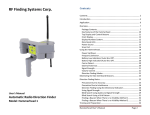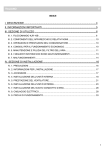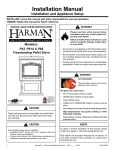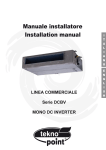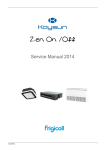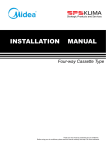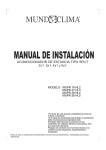Download ROOM AIR CONDITIONER - Ductless Mini Split
Transcript
Before using your air conditioner, please read this manual carefully and keep it for future reference. INVERTER ONE-TWO / ONE-THREE /ONE- FOUR/ONE-FIVE SPLIT-TYPE ROOM AIR CONDITIONER Please read this installation manual completely before installing the product. If the power cord is damaged, replacement work shall be performed by authorised personnel only. Installation work must be performed in accordance with the national wiring Standards by authorised personnel only. Contact an authorised service technician for repair, maintenance or installation of this unit. CONTENTS SAFETY PRECAUTIONS Warning ...........................................................................................................................................2 Caution ............................................................................................................................................2 INSTALLATION INSTRUCTIONS Selecting installation place...............................................................................................................3 Wall-mounted type ...........................................................................................................................3 Accessories .........................................................................................................4 Four-way cassette type ................................................................................................................9 Duct & Ceiling type .......................................................................................................................15 Ceiling and Floor type ....................................................................................................................21 Floor and Standing type(Console)..................................................................................................24 Outdoor unit installation ................................................................................................................28 REFRIGERANT PIPE CONNECTION Refrigerant pipe connection ..........................................................................................................29 ELECTRICAL WORK Electrical work .................. ...........................................................................................................30 AIR PURGING Air purging with vacuum pump .....................................................................................................35 Safety and leakage check ............................................................................................................36 TEST RUNNING Test running ..................................................................................................................................37 Read This Manual Inside you will find many helpful hints on how to install and test the air conditioner properly. All the illustrations and specifications in the manual are subject to change without prior notice for product improvement. The actual shape should prevail. CAUTION Contact an authorised service technician for repair or maintenance of this unit. The appliance shall be installed in accordance with national wiring regulations. This appliance is not intended for use by persons(including children) with reduced physical, sensory or mental capabilities, or lack of experience and knowledge, unless they have been given supervision or instruction concerning use of the appliance by a person responsible for their safety. Young children should be supervised to ensure that they do not play with the air conditioner. Do not operate your air conditioner in a wet room such as a bathroom or laundry room. Installation work must be performed in accordance with the national wiring standards by authorised personnel only. 1 SAFETY PRECAUTIONS Read the follow SAFETY PRECAUTIONS carefully before installation. Electrical work must be installed by a licensed electrician. Be sure to use the correct rating of the power plug and main circuit for the model to be installed. Incorrect installation due to ignoring of the instruction will cause harm or damage. The seriousness is classified by the following indications. WARNING This symbol indicates the possibility of death or serious injury. CAUTION This symbol indicates the possibility of injury or damage to property. The items to be followed are classified by the symbols: Symbol with background white denotes item that is PROHIBITED from doing. WARNING 1) Engage dealer or specialist for installation. If installation done by the user is defective, it will cause water leakage, electrical shock or fire. 2) Install according to this installation instructions strictly. If installation is defective, it will cause water leakage, electrical shock or fire. 3) Use the attached accessories parts and specified parts for installation. otherwise, it will cause the set to fall, water leakage, electrical shock or fire. 4) Install at a strong and firm location which is able to withstand the set ,s weight. If the strength is not enough or installation is not properly done, the set will drop and cause injury. 5) For electrical work, follow the local national wiring standard, regulation and this installation instructions. An independent circuit and single outlet must be used. If electrical circuit capacity is not enough or defect found in electrical work, it will cause electrical shock or fire. 6) Use the specified cable and connect tightly and clamp the cable so that no external force will be acted on the terminal. If connection or fixing is not perfect, it will cause heat-up or fire at the connection. 7) Wiring routing must be properly arranged so that control board cover is fixed properly. If control board cover is not fixed perfectly, it will cause heat-up at connection point of terminal, fire or electrical shock. 8) When carrying out piping connection, take care not to let air substances other than the specified refrigerant go into refrigeration cycle. Otherwise, it will cause lower capacity, abnormal high pressure in the refrigeration cycle, explosion and injury. 9) Do not modify the length of the power supply cord or use of extension cord, and do not share the single outlet with other electrical appliances. Otherwise, it will cause fire or electrical shock. CAUTION 1) This equipment must be earthed and installed with earth leakage current breaker. It may cause electrical shock if grounding is not perfect. 2) Do not install the unit at place where leakage of flammable gas may occur. In case gas leaks and accumulates at surrounding of the unit, it may cause fire. 3) Carry out drainage piping as mentioned in installation instructions. If drainage is not perfect, water may enter the room and damage the furniture. 4) The appliance shall be installed in accordance with national wiring regulations. 5) Do not operate your air conditioner in a wet room such as a bathroom or laundry room. 6) An all-pole disconnection device which has at least 3mm clearances in all poles , and have a leakage current that may exceed 10mA, the residual current device (RCD) having a rated residual operating current not exceeding 30mA, and disconnection must be incorporated in the fixed wiring in accordance with the wiring rules. 2 INSTALLATION INSTRUCTIONS 1. Wall-mounted type Selecting installation place More than 15cm Read completely, then follow step by step. Indoor unit More than 12cm Do not expose the indoor unit to heat or steam. More than 12cm Select a place where there are no obstacles in front or around the unit. Make sure that condensation drainage can be conveniently routed away. More than 2.3m Do not install near a doorway. Fig.1 Ensure that the space on the left and right of the unit is more than 12cm. Use a stud finder to locate studs to prevent unnecessary damage to the wall. The indoor unit should be installed on the wall at a height of 2.3 metres or more from the floor. The indoor unit should be installed allowing a minimum clearance of 15cm from the ceiling. Any variations in pipe length will/may require adjustment to refrigerant charge. There should not be any direct sunlight. Otherwise, the sun will fade the plastic cabinet and affect its appearance. If unavoidable, sunlight prevention should be taken into consideration. Outdoor unit More than 30cm If an awning is built over the outdoor unit to prevent direct sunlight or rain exposure, More than 30cm make sure that heat radiation from the condenser is not restricted. Ensure that the clearance around the back More than 60cm of the unit is more than 30cm and left side is more than 30cm. The front of the unit should have more than 200cm of clearance and the More than 200cm connection side (right side) should have more Fig.2 than 60cm of clearance. Do not place animals and plants in the path of the air inlet or outlet. Take the air conditioner weight into account and select a place where noise and vibration will not be an issue. Select a place so that the warm air and noise from the air conditioner do not disturb neighbors. Rooftop installation: If the outdoor unit is installed on a roof structure, be sure to level the unit. Ensure the roof structure and anchoring method are adequate for the unit location. Consult local codes regarding rooftop mounting. If the outdoor unit is installed on roof structures or external walls, this may result in excessive noise and vibration, and may also be classed as a non serviceable installation. 3 INSTALLATION INSTRUCTIONS Tools needed for installation: Level gauge Screwdriver Electric drill,Hole core drill (φ65mm) Flaring tool set Specified torque wrenches: 1.8kgf.m, 4.2kgf.m, 5.5kgf.m, 6.6kgf.m(different depending on model No.) Spanner (half union) Hexagonal wrench (4mm) Gas-leak detector Vacuum pump Gauge manifold Users manual Thermometer Multimeter Pipe cutter Measuring tape Accessories Number Q’ty/one unit Name of Accessories 1 5-8 1 Installation Plate 2 Plastic Expansion Sheath (depending on models) 3 Self-tapping Screw A ST3.9X25 (depending on models) 4 Connecting pipe Assembly Liquid side Gas side 5-8 6.35 9.52 9.52 12.7 15.9 Parts you must purchase Consult the technician for the proper size. 5 Remote controller 1 6 7 8 Self-tapping Screw B ST2.9X10 Optional parts Remote controller holder Seal (for cooling& heating models only) 2 9 Drain Joint (for cooling& heating models only) Transfer connector ( Packed with the indoor unit or 1 10 11 12 outdoor unit, depending on models ) (NOTE: Pipe size differ from appliance to appliance. To meet different pipe size requirement, sometimes the pipe connections need the transfer connector to install on the outdoor unit .) Magnetic ring (Hitch it on the connective cable between indoor unit and outdoor unit after installation.) Cord protection rubber ring (If the cord clamp can not fasten the cord for the small size of the cord, please use the cord protection rubber ring (supplied with accessories) to wrap on the cord, then fix it with the cord clamp.) 1 1 Optional part (one piece/one indoor unit) Optional part (1-5 pieces for outdoor unit, depending on models) Optional part (one piece/one cable) 1 (on some models) Note: Except the above parts provided, the other parts needed during installation you must purchase. 4 INSTALLATION INSTRUCTIONS Mor 2 e tha n 12 M or e th an cm More than 15cm 1 12 cm More 1 2 c m th a n 3 M or e th an 12 cm Ai r fil te r A ir fi lt er Ai r fil te r Ai r fil te r 4 5 Remote Remote controller Remote controller controller Mor e tha n 12 cm Mo 10c re tha m n Air out More than 60cm Remote controller 6 tha re Mo cm 0 3 n A A ir fi lt er Remote controller Mo re th a 0 n2 0c Mo 60 re th cm an m C B Loop a connective cable One-Two One-Three One-Four One-Five Fig.3 CAUTIONS This illustration is for explanation purposes only. The actual shape of your air condtioner may be slightly different. Copper lines must be insulated independently CAUTION Use a stud finder to locate studs to prevent unnecessary damage to the wall. A minimum pipe run of 3 metres is required to minimise vibration & excessive noise. Two of the A, B and C directions should be free from obstructions. 5 INSTALLATION INSTRUCTIONS Indoor unit installation(wall-mounted type) Correct orientation of Installation Plate 1. Fit the Installation Plate 1 . F it th e i nstal l a t i o n p late ho r izontally o n s tructural p a rts of t h e wal l w ith s p a c e s a round t h e ins t a l l a t i o n plat e . 2 . I f th e w all is m ade of b rick, co n c rete o r t he li k e , d rill fi v e o r ei g h t 5 mm dia m e t e r Fig.4 h o l e s i n th e w all.Ins e r t C lip an c h o r f or a p p r o p r iate mo u n t i n g s crew s . 3 . F it th e i nstal l a t i o n p late on t he wa l l w i t h f ive or e ight typ e ? A ? scr e w s . Note: Fit the Installation Plate and drill holes in the wall according to the wall structure and indoor unit dimensions and the corresponding mounting points on the installation plate. The Installation Plate may be slightly different according to the different models of indoor unit. See Fig.5 for example. (D i m e n s i o ns are i n ? mm? u n l ess ot h e r w i s e s tated . ) R Installation plate 45 Left rear side refrigerant pipe hole φ65 45 H 120mm or more to wall W 120mm or more to wall Right rear side refrigerant pipe hole φ65 Model A Mounting dimensions 790x265 100 150 920x292 150 185 1080x330 70 105 790x275 100 85 930x275 150 205 998x322 100 120 680x255 170 92 770x255 170 95 905x275 80 100 750x280 180 110 835x280 140 110 990x315 260 135 1186x343 275 275 900x290 83 170 1045x305 100 170 715x250 85 88 800x275 100 95 940x275 110 100 1045x315 293 163 795x270 150 160 845x286 150 186 995x295 150 200 1084x320 150 140 850x275 100 130 900x285 150 90 1015x298 150 200 850x290 100 115 L R H 160 W Model B Indoor unit outline L 150mm or more to ceiling Installation plate R 120mm or more to wall 120mm or more to wall Left rear side refrigerant pipe hole φ65 45 R(Right) 100 45 L(Left) 710x250 H Indoor unit dimension mm(WxH) 150mm or more to ceiling L Indoor unit outline W Model C Fig.5 6 Right rear side refrigerant pipe hole φ65 INSTALLATION INSTRUCTIONS 2. Drill a hole in the wall Wall 1. Determine hole positions according to the diagramdetailed in Fig.5. Drill one (1) hole (φ65mm) slanting slightly to outdoor side. 2. Always use wall hole conduit when drilling metal grid, metal plate or the like. Outdoor 5-7mm Indoor Fig.6 3. Connective Pipe and Drainage Installation Drainage 1. Run the drain hose sloping downward. Do not install the drain hose as illustrated in Fig.7. Do not put the end of drain hose into water. Do not block water flow by a rise. 2. When connecting extension drain hose, insulate the connecting part of extension drain hose with a shield pipe, do not let the drain hose slack. Fig.7 Connective pipe installation 1. For the left-hand and right-hand piping, remove the pipe cover from the side panel. 2. For the rear-right-hand and rear-left-hand piping, install the piping as shown in Fig.10. 3. Fix the end of the connective pipe. (Refer to Tightening Connection in REFRIGERANT PIPING CONNECTION) Fig.8 Rear-right piping Right-hand piping 4. Piping and wrapping Bundle the tubing, connecting cable, and drain hose with tape securely, evenly as shown in Fig.11. Because the condensed water from rear of the indoor unit is gathered in ponding box and is piped out of room. Do not put anything else in the box. CAUTION Connect the indoor unit first, then the outdoor unit. Do not allow the piping to let out from the back of the indoor unit. Be careful not to let the drain hose slack. Heat insulated both of the auxiliary piping. Be sure that the drain hose is located at the lowest side of the bundle. Locating at the upper side can cause drain pan to overflow inside the unit. Never intercross nor intertwist the power wire with any other wiring. Run the drain hose sloped downward to drain out the condensed water smoothly. Rear-left piping Left-hand piping Fig.9 Fig.10 Indoor unit Ponding box Connective cable Pipe room ...... . .. ...... .. .. . ... ..... . . . Drain hose Fig.11 7 Connective pipe Wrapping belt INSTALLATION INSTRUCTIONS 4. Indoor unit installation 1. Pass the piping through the hole in the wall. 2. Put the upper claw at the back of the indoor unit on the upper hook of the installation plate, move the indoor unit from side to side to see that it is securely hooked (see Fig.12). 3. Piping can easily be made by lifting the indoor unit with a cushioning material between the indoor unit and the wall. Get it out after finish piping. 4. Push the lower part of the indoor unit up on the wall, then move the indoor unit from side to side, up and down to check if it is hooked securely. Fig.12 1 drive 2 1 drive 3 1 drive 4 1 drive 5 Max. Length for all rooms Max. Length for one indoor unit Max. height different between OU higher than IU indoor and outdoor unit OU lower than IU Max. height different between indoor units 8 30m 45m 60m 75m 20m 25m 30m 30m 10m 10m 10m 10m 15m 15m 15m 15m 10m 10m 10m 10m INSTALLATION INSTRUCTIONS 2. Four-way cassette type Attached fittings Please check whether the following fittings are of full scope. If there are some attached fittings free from use, please restore them carefully. (on some models) 1.Installation manual.................................1 2.Owner's manual.....................................1 3. Remote controller.............................1 (on some models) 5.Out-let pipe sheath..............................1 6.Out-let pipe Clasp.................................1 7.Drain joint..............................................1 8. Installation paper board.....................1 11. Expansible hook..............................4 12. Installation hook..............................4 13. Orifice.............................................1 4. Alkaline dry batteries (AM4)............2 14. Frame.............................................1 9. Soundproof / insulation sheath.........1 10. Seal ring..........................................1 15. Mounting screw(ST2.9×10-C-H) ...2 A 280 Necessary room Outlet Inlet Outlet >2300 Notes before installation 1. Decide the correct carry-in path. 2. Move this unit as originally packaged as possible. 3. If the air conditioner is installed on a metal part of the building, it must be electrically insulated according to the relevant electrical code. 4. If installing in a lonely building or at a high position where it is hot and humid with frequent thunderstorm, lightning-protection equipment is necessary. Ground >1000 Fig.13 >1000 >1000 >1000 Indoor unit installation 1. Install the main body A. The existing ceiling (to be horizontal) a. Please cut a quadrangular hole of 600×600mm in the ceiling according to the shape of the installation paper board. (Refer to Fig.15 & 16) The center of the hole should be at the same position of that of the air conditioner body. Determine the lengths and outlets of the connecting pipe, drain pipe and cables. To balance the ceiling and to avoid vibration, please enforce the ceiling when necessary. b. Please select the position of installation hooks according to the hook holes on the installation board. Drill four holes of 12mm, 50~55mm deep at the selected positions on the ceiling. Then embed the expansible hooks(fittings). Face the concave side of the installation hooks toward the expansible hooks. Determine the length of the installation hooks from the height of ceiling, then cut off the unnecessary part. If the ceiling is extremely high, please determine the length of the installation hook according to facts. Cut the installation hook open in the middle position, then use apropriate length of reinforcing rod ( 12) to weld together. Fig.14 Fig.15 9 INSTALLATION INSTRUCTIONS New built houses and ceilings a. In the case of new built house, the hook can be embedded in advance (refer to the A.b mentioned above). But it should be strong enough to bear the indoor unit and will not become loose because of concrete shrinking. b. After installing the body, please fasten the installation paper board onto the air conditioner with bolts (M5×16) to determine in advance the sizes and positions of the hole opening on ceiling. Please , first guarantee the flatness and horizontal of ceiling when installing it. Refer to the A.a mentioned above for others. c. Refer to the A.c mentioned above for installation. d. Remove the installation paper board. A Hook Body 285 Nut Panel Ceiling 600 Fig. 16 34 Body Ceiling Colourless trans parent pipe Fig. 17 Horizontal indicator Fig.18 Body Fig.19 Fresh air intake (o65) Fixing hole Installation paper board Hook hole Screw M5×16 (Accessory) 2. Install The Panel CAUTIONS Never put the panel face down on floor or against the wall, or on bulgy objects. Never crash or strike it. Installation paper board Fig.20 (1) Remove the inlet grid. a. Slide two grid switches toward the middle at the same time, and then pull them up. (Refer to Fig.21) b. Draw the grid up to an angle of about 30o, and remove it. (Refer to Fig.22) Grid switch Fig.21 o 45 Fig.22 10 Central hole 176 10-12 L H(ceiling height) The length could be calculated from Fig.17: Length=210+L(in general, L is half of the whole length of the installation hook) c. Please adjust the hexangular nuts on the four installation hooks evenly, to ensure the balance of the body. Use the transparent hose filled with water to check the level of the main body from the four sides or diagonal line direction, the lever indicator also can check the lever from four sides of the main body .(Refer to Fig.18) If the drainpipe is awry, leakage will be caused by the malfunction of the water-level switch. Adjust the position to ensure the gaps between the body and the four sides of ceiling are even. The body's lower part should sink into the ceiling for 10~12mm (Refer to Fig.17). Locate the air conditioner firmly by wrenching the nuts after having adjusted the body's position well. INSTALLATION INSTRUCTIONS (2) Install the panel a. Align the swing motor on the panel to the water receiver of the body properly. (Refer to Fig.23) b. Hang the four fixed rope of the main body to the installation cover and the other three covers of the swing motor: (Refer to Fig.23 ) Drain side Drain side 1 Steel rope 2 CAUTIONS: 33 The installation cover of the swing motor must sink into the corresponding water receiver. c. Install the panel on the main body with bolt (M5×16) and washer. (Refer to Fig.23) d. Adjust the four panel hook screws to keep the panel horizontal, and screw them up to the ceiling evenly. e. Regulate the panel slightly to fit the panel's center to the center of the ceiling's opening. Guarantee that hooks of four corners are fixed well. f. Keep fastening the screws under the panel hooks, until the thickness of the sponge between the body . and the panel's outlet has been reduced to about . 4~6mm. The edge of the panel should contact with the ceiling well. (Refer to Fig.24) Malfunction described in Fig.25 can be caused by inappropriate tightness the screw. If the gap between the panel and ceiling still exists after fastening the screws, the height of the indoor unit should be modified again. You can modify the height of the indoor unit through the openings on the panel's four corners, if the lift of the indoor unit and the drainpipe is not influenced (refer to Fig.26-right). Cover Swing motor installation cover 4 Please operate according to the direction of the arrow, or it can not be disassembled when it is necessary. Bolt, washer Swing motor side Fig.23 Body Ceiling Inlet air Panel sealing foam Panel foam2 Panel foam Outlet air Air plate Fig.24 Ceiling (3) Hang the air-in grid to the panel, then connect the lead terminator of the swing motor and that of the control box with corresponding terminators on the body respectively. (4) Relocate the air-in grid in the procedure of reversed order, install the air-in grid. Leakage Dew Fig.25 Hexagon nut Horizontal adjust ment (3) The installation of ventilation motor and ventilation pipe (if necessary) a. Using a tool to knock off the pre-punching hole. (Refer to Fig.27) b. Four screw hole reserved for installation. (Refer to Fig.27 ) Ceiling Fig.26 Four screw hole pre-punching hole Fig.27 11 Panel Panel foam1 INSTALLATION INSTRUCTIONS (4) water-pump drainage The maximum lifting height is 750mm. Fig.28 3. Drainage pipe installation (1) Installation principle Ensure at least 1/100 slope of the drainage pipe. Adopt suitable pipe diameter. Adopt nearby condensate water discharge. Before installing condensate water pipeline, determine its route and elevation to avoid intersection with other pipelines and ensure slope is straight. In general, the supporter gap of the drainage pipe horizontal pipe and vertical pipe is respectively 1m~1.5m and 1.5m~2.0m. Too long distance Gas bag Fig.29 (2) Drainage pipe selection The drainage pipe diameter shall not small than the drain hose of indoor unit. According to the water flowrate and drainage pipe slope to choose the suitable pipe, the water flowrate is decided by the capacity of indoor unit. Capacity(x1000Btu/h) 12 18 24 30 36 42 48 60 Water flowrate(l/h) 2.4 4 6 7 8 10 12 14 According to the above table to calculate the total water flowrate for the confluence pipe selection. 12 INSTALLATION INSTRUCTIONS For horizontal drainage pipe(The following table is for reference) Attention: Adopt PVC40 or bigger pipe to be the main pipe. Reference value of inner diameter of pipe (mm) PVC pipe PVC PVC PVC PVC PVC Allowable maximum water flowrate (l/h) Slope 1/100 Slope 1/50 20 25 31 40 51 25 32 40 50 63 Remark 27 50 88 175 334 39 70 125 247 473 For branch pipe Could be used for confluence pipe For vertical drainage pipe(The following table is for reference) Attention: Adopt PVC40 or bigger pipe to be the main pipe. PVC pipe PVC PVC PVC PVC PVC Reference value of inner diameter of pipe (mm) Allowable maximum water flowrate (l/h) 20 25 31 40 51 25 32 40 50 63 Remark 220 410 730 1440 2760 For branch pipe Could be used for confluence pipe The horizontal pipe layout should avoid converse flow or bad flow: Drainage pipe Drainage pipe Water flow Water flow Water flow Drainage pipe Water flow Drain tee Drain tee Water flow Water flow Water flow Water flow Water flow Branch pipe Water flow Drain tee Gas Gas Water flow Keep a certain degree Main pipe Main pipe Branch pipe Fig.30 13 INSTALLATION INSTRUCTIONS (3) Water storage pipe setting If the indoor unit has high extra static pressure and without water pump to elevate the condensate water, such as high extra static pressure duct unit, the water storage pipe should be set to avoid converse flow or blow water phenomena. Indoor unit More than 50mm Plug More than 25mm Water storage pipe Fig.31 (4) Lifting pipe setting of indoor unit with water pump The length of lifting pipe should not exceed the pump head of indoor unit water pump. Pump head of big four way cassette:750mm. Pump head of compact four way cassette: 500mm(9k, 12k, 18k units). The drainage pipe should be set down inclined after the lifting pipe immediately to avoid wrong operation of water level swithch. Refer the following picture for installation reference. Hanger Down incline pipe A A:Length of horizontal pipe ≤ 150mm B: Lift height ≤ the pump head of water pump B Flexible pipe 300mm Fig.32 (5) Blowhole setting For the concentrated drainage pipe system, there should design a blowhole at the highest point of main pipe to ensure the condensate water discharge smoothly. The air outlet shall face down to prevent dirt entering pipe. Each indoor system should be installed it. The installation should be considering the convenience for future cleaning. Blowhole Indoor unit Indoor unit Plug Plug Fig.33 14 INSTALLATION INSTRUCTIONS 3. Duct & Ceiling type Installation precautions 1. Determine the moving route. 2. Move the unit in original state. 3. Make sure to do electric insulation according to relevant electric standard in case the unit is installed on metal part of building. 4. Please keep away from the following places, or malfunction may be caused. (if unavoidable, please consult the professionals): A. There is mineral oil like the oil of cutting machine. B. There is much salty air. (Near the coast) C. There is caustic gas such as sulfuric gas. (Near the hotspring.) D. Factory where the voltage fluctuate greatly. E. In the car or in the cabin. F. In the kitchen or a place full of oil steam.. G. There is strong electromagnetic wave. H. There is combustible gas or materials. I. There is much evaporating acid or alkaline gas. J. Other special areas. Accessories NO Qty. Name Outline Function 1 Insulation pipe 2 Pipe joint heat insulation 2 Remote controller 1 Remote control air conditioner 3 Big washer 8 Overhang indoor unit 4 Constriction bandage 10 Binding insulation pipe 5 Water outlet joint (for cool/heat type only) 1 Outdoor unit drainage 6 Gasket (for cool/heat type only) 1 Outdoor unit drainage 7 Copper nut 2 Connecting pipe 8 Drain hose 1 Indoor unit drainage 9 7# Alkaline battery 1 10 Remote signal receiver subassembly 1 11 Magnetic ring 1 Indoor unit installation Installation location Enough room for installation and maintenance. Air outlet Refrigerant pipe <1000mm Air outlet <500mm Duct <500mm Direction A >250mm >100mm >200mm Air return box Air return box <3m Air return box Direction A The ceiling is horizontal and it can afford the weight of the indoor unit. The air inlet and outlet are not impeded and does not affected by outdoor air too much. The air flow can reach every part of the room. The connecting pipe and drainpipe can be easily extracted out. There is no direct radiation from heat source. 15 INSTALLATION INSTRUCTIONS Installation of unit Install φ10 (4 pieces)hanging screw bolt Determine the location of hanging screw bolt following Fig.40. Make sure to use the hanging screw bolt of φ10. The treatment to the ceiling varies from construction; please consult the professionals for details. 1) Treatment to ceiling---make sure to consolidate the roof beam for possible vibration to keep the ceiling horizontal. 2) Please cut off the roof beam. 3) Reinforce the place that is cut off and consolidate the roof beam. Carry out connection of piping and wiring inside the ceiling. Determine the piping direction. Especially in the case of existing ceiling, please pull the wire to the connection place before overhanging the unit. Install the hanging bolt in following different situation: Wooden structure Original concrete bricks Install the hanging hook with expansible bolt into the concrete. Put a timber across the beams and install the bolts. Timber over the beam Roof beam Ceiling Fig.35 Hanging screw bolts Fig.34 Steel roof beam structre New concrete bricks Install with insertion or embedding screw. Install the supporting angle steel. Hanging screw bolt Steel bar (Blade shape (Slide insertion) insertion) (Pipe hanging and embedding screw bolt) Hanging bolts Supporting angle steel Fig.37 Fig.36 Overhang the unit Install the hanging screw bolt to the U-shaped slot of installation ear. Overhang the indoor unit and measure the level degree of unit with a gradienter. Fasten and fix the upside nut. Gradienter Hanging screw bolt Nut (upside) Washer (upside) Installation ear Fasten the nut Fig.39 Washer (underside) Nut (underside) Fig.38 16 INSTALLATION INSTRUCTIONS The position of hanging bolts Dimension and air outlet size Air inlet size Air filter Position size of descensional ventilation opening Air filter Electric control box Size of mounted hook Electric control box Fig.40 17 INSTALLATION INSTRUCTIONS Air outlet opening size Outline dimension A B C D E <12000Btu/h 700 210 635 570 65 >12000Btu/h 920 210 635 570 65 F G 493 713 35 35 H Air return opening size I J 119 595 200 119 815 200 K 80 80 Size of mounted lug L M 740 350 960 350 How to adjust the air inlet direction?(From rear side to under-side.) 1. 2. Take off ventilation panel and flange, cut off the staples at side rail. Stick the attached seal sponge as per the indicating place in the following fig, and then change the mounting positions of air return panel and air return flange . Air return flange Side rail Dentilation panel 3. Seal sponge When install the filter mesh, please plug it into flange inclined 4. from air return opening, and then push up. The installation has finish, upon filter mesh which fixing blocks have been insert to the flange positional holes. Fig.41 NOTE All the figures in this manual are for explanation purpose only. They may be slightly different from the air conditioner you purchased.The actual unit shall prevail. 18 17 INSTALLATION INSTRUCTIONS Drainpipe installation 1. Indoor unit drainpipe installation Piping, insulation material Piping Fig.42 Hard PVC pipe Insulation material Cellular polyethylene, thicker than 6mm No space Drainage See Fig.42 Hard PVC pipe Heat insulation material Seal the insulation material Heat insulation Please do heat insulation on piping joint. Bind the contact insulation part between the unit and installation location with bandage. Fig.43 19 Heat insulation material Main unit INSTALLATION INSTRUCTIONS CAUTION 1.5m~2m Supporting Unit The drain pipe as well as the connection part of indoor unit must be heat insulated, or condensate will occur. Please connect the pipe with horny PVC bond and make sure there is no leakage. Do not impose the pressure on connecting part of drainpipe. The gradient downwards of drain pipe should be over 1/100, and do not bend the drain pipe. Pull the drain pipe transversely within 20m. Please install a supporter in case the drainpipe is very long to prevent it from bending. Refer to the figures on the right for the installation of pipes. Lean Downward over 1/100 Fig.44 Fold Bend Fig.45 As long as possible (10cm) Accessories installation i nstruction for duct Duct design Make the duct as short as possible due to the low static pressure (nearly 0 pa) of this unit. Lean Downward over 1/100 Fig.46 Fix installation board Fix the installation board on duct outlet with the bolts in accessories. If the bolt is self-provided, the length of bolt should be appropriate and make sure not to damage the inside of unit. See Fig.47 Duct installation Fix the duct on installation board with rivet. See Fig.48 NOTE: 1.Do not let the indoor unit bear the weight of duct. 2.For convenient maintenance, install the duct at the place where it is easy to do removing. 3.In case doing installation in meeting room or such places, please equip the interior with liner and muffler. 4.These accessories are optional. Please contact the service for other requirement. Fig.47 Fig.48 Accessories Name Duct installation board Fixation bolt (fixing installation board) Qty. Outline/specification Function 8 8 Connecting duct ST3.9×10-F-H Fixing duct installation board 20 VP30 INSTALLATION INSTRUCTIONS 4. Ceiling and Floor type 4.1 Accessories Name of Accessories Q'ty Qutline Remote Controller & Its Frame (on some models) Usage Owner's manual 1 InstallatiOn manual 1 Hook 2 For wall mounting instal lation Hanging ar m 2 For ceiling installation Magnetic ring 1 For wire connetion 1. Remote controller..................1 (This manual) 2. Frame...................................1 3. Mounting screw (ST2.9x10-C-H).....................2 4.. Alkaline dry batteries(AM4) ...............................................2 Cautions on remote controller installation Never throw or beat the controller. Before installation,operate the remote controller to determine its location in a reception range. Keep the remote controller at least 1m apart from thenearest TV set or stereo equipment. (It is necessary to prevent image disturbances or noise interferences.) Do not install the remote controller in a place exposed to direct sunlight or close to a heating source, such as a stove. Note that the positive and negative poles are in right positions when loading batteries. 3 Mounting screw B ST2.9x10-C-H 1 Remote controller 2 Remote controller holder Fig.49-1 21 INSTALLATION INSTRUCTIONS 4.2 Indoor unit installation 4. For original concrete bricks Use embedding screw bold, crock and stick harness (Refer to Fig.49-4). 1. Installing 10 hanging screw bolts (4 bolts). Please refer to the following figure for the distance measurement between the screw bolts. Please install with 10 hanging screw bolts. The handling to the ceiling varies from the constructions, consult the construction personnels for the specific procedures. The size of the ceiling to be handled----do keep the ceiling flat. Consolidate the roof beam for possible vibration. Cut off the roof beam. Strengthen the place cut off, and consolidate the roof beam. Carry out the pipe and line operation in the ceiling after finishing the installation of the mainbody.While choosing where to start the operation, determine the direction of the pipes to be drawn out. Especially in case there is a ceiling, position the refrigerant pipes, drain pipes,indoor & outdoor lines to the connection places before hanging up the machine. The installation of hanging screw bolts. Steel bar Embedding screw bolt (Pipe hanging and embedding screw bolt) Fig.49-4 5. Steel roof beam structre Install and use directly the supporting angle steel. (Refer to Fig.49-5) Hanging screw bolt Supporting angle steel Hanging bolts Fig.49-5 4.3 Wall Mounting Installation 2. Wooden construction D. Connecting point of refrigerant pipe (D. gas side) Put the square timber traversely over the roof beam, then install the hanging screw bolts. (Refer to Fig.49-2) Drain point E. Connecting point of refrigerant pipe (E. Liquid side) Timber over the beam Hook Roof beam Ceiling Hanging screw bolts Fig.49-2 3. New concrete bricks Inlaying or embedding the screw bolts. (Refer to Fig.49-3) (Blade shape insertion) Fig.49-6 (Slide insertion) Fig.49-3 22 INSTALLATION INSTRUCTIONS 1. Fix the hook with tapping screw onto the wall. (Refer to Fig.49-7) 2. Hang the indoor unit on the hook. 20 ~25mm 2. Location the hanging arm on the hanging screw bolt. (Refer to Fig.49-10) Prepare the mounting bolts on the unit. (Refer to Fig.49-11) Hook 8-13mm Screw nut Washer Hanging screw bolt Hanging arm Tapping screw Mounting bolt (Max.40mm) Fig.49-11 Fig.49-10 Washer 3. Hang the unit on the hanging arm by sliding backward. Securely tighten the mounting bolts on both sides. (Refer to Fig.49-12) <6mm Hanging Screw bolt Fig.49-7 Hanging arm 4.4 Ceiling Installation Mounting bolt D. Connecting point of refrigerant pipe(D.gas side) E. Connecting point of refrigerant pipe (E. Liquid side) Hanging arm Drain point Fig.49-8 Fig.49-12 1. Remove the side board and the grille. (Refer to Fig.49-9) (For 48000Btu/h and 60000Btu/h models, do not remove the grille.) ≥ 35mm ≥ 35mm ≥35mm Side board ≥1000mm Fig.49-13 CAUTION Grille The figures aboe are based on model with 18000Btu/h as rated capacity, which may differ from the unit you purchased. Fig.49-9 23 INSTALLATION INSTRUCTIONS . This manual is subject to changes due to technological improvement without further notices. 4.5 The Dimension of the Unit Unit:mm Capacity 12-18 A B C 990 660 206 D 505 F G H 907 200 203 E 506 Mounting screw B ST2.9x10-C-H SET TEMPERATURE?? Note:The dimension of 12000Btu/h and 18000Btu/h are the same. O C) AUTO COOL DRY HEAT FAN HIGH MED LOW TEMP. MODE ON/OFF FAN SPEED SWING ECONOMIC TIMER ON RESET LOCKTIMER OFF 5. Floor and Standing Type (Console) AIR DIRECTION Remote controller holder 5.1 Accessories(Console) Remote controller Please check whether the following fittings are of full scope. If there are some spare fittings, please restore them carefully. NAME Installation fittings Remote controller & Its Frame (on some models) SHAPE POWERFUL Fig.50-1 5.2 Inspecting and Handling the unit(Console) QUANTITY 1.Hook 2 2. Magnetic ring 1 3. Remote controller 1 4. Frame 1 5. Mounting screw (ST2.9 10-C-H) 2 6. Alkaline dry batteries (AM4) 2 7. Owner's manual 1 8. Installation manual 1 At delivery, the package should be checked and any damage should be reported immediately to the service agent. When handling the unit, take into account the following: 1. Fragile, handle the unit with care. 2. Keep the unit upright in order to avoid compressor damage. 3. Choose on before hand the path along which the unit is to be brought in. 4. Move this unit as originally package as possible. 5. When lifting the unit , always use protectors to prevent belt damage and pay attention to the position of the , unit s centre of gravity. Others 5.3 Indoor Unit Installation(Console) 5.3.1 Installation place Cautions on remote controller installation: The indoor unit should be installed in a location that meets the following requirements: There is enough room for installation and maintenance. (Refer to Fig.50-2 & Fig.50-3) The outlet and the inlet are not impeded, and the influence of external air is the least. The air flow can reach throughout the room. The connecting pipe and drainpipe could be extracted out easily. There is no direct radiation from heaters. Never throw or beat the controller. Before installation, operate the remote controller to determine its location in a reception range. Keep the remote controller at least 1m apart from the nearest TV set or stereo equipment. (it is necessary to prevent image disturbances or noise interferences.) Do not install the remote controller in a place exposed to direct sunlight or close to a heating source, such as a stove. Note that the positive and negative poles are right positions when loading batteries. 24 INSTALLATION INSTRUCTIONS Hang the indoor unit on the hook. (The bottom of body can touch with floor or suspended, but the body must install vertically. ) CAUTION Keep indoor unit, outdoor unit, power supply wiring and transmission wiring at least 1 meter away from televisions and radios. This is to prevent image interference and noise in those electrical appliances. (Noise may be generated depending on the conditions under which the electric wave is generated, even if 1 meter is kept.) ≥100mm ≥100mm ≥100mm ≥1000mm Fig.50-5 Fig.50-2 5.4 Install the connecting pipe (Console) 210mm 700mm 600mm Check whether the height drop between the indoor unit and outdoor unit, the length of refrigerant pipe, and the number of the bends meet the following requirements: Capacity(KBtu/h) 7/9/12 18/20/26/32/53 The max height drop 5m 10m The length of refrigerant pipe Less than 10m Less than 20m The number of bends Less than 5m Less than 5 195mm 5.4.1 The procedure of connecting pipes: Hook CAUTION All field piping must be provided by a licensed refrigeration technician and must comply with the relevant local and national codes. Do not let air, dust, or other impurities fall in the pipe system during the time of installation. The connecting pipe should not be installed until the indoor and outdoor units have been fixed already. Keep the connecting pipe dry, and do not let moisture in during installation. Execute heat insulation work completely on both sides of the gas piping and the liquid piping. Otherwise, this can sometimes result in water leakage. Fig.50-3 5.3.2 Install the main body Fix the hook with tapping screw onto the wall. (Refer to Fig.50-4) Hook Tapping screw 195 mm Washer <6mm Fig.50-4 25 INSTALLATION INSTRUCTIONS 1. Drill a hole in the wall (suitable just for the size of the wall conduit), then set on the fittings such as the wall conduit and its cover. 2. Bind the connecting pipe and the cables together tightly with binding tapes. Pass the bound connecting pipe through the wall conduct from outside. Be careful of the pipe allocation to do on damage to the tubing. 3. Connect the pipes. Refer to "How to Connect the pipes" for details. 4. Expel the air with a vacuum pump. Refer to "How to expel the air with a vacuum pump" for details. 5. open the stop values of the outdoor unit to make the refrigerant pipe connecting the indoor unit with the outdoor unit in fluent flow. 6. Check the leakage. Check all the joints with the leak detector or soap water. 7. Cover the joints of the connecting pipe with the soundproof / insulating sheath (fittings), and bind it well with the tapes to prevent leakage. 2. Remove the front panel Remove the string. (Refer to Fig.50-7). Allowing the front panel to fall forward will enable you to remove it. Fig.50-7 3. Remove the face plate Remove the four screws.(Refer to Fig.50-7). Opening bottom of face plate for a angle that is 30 degrees, then the top of face plate will be take up.(Refer to Fig.50-8) CAUTION Be sure to with insulating materials cover all the exposed parts of the flare pipe joints and refrigerant pipe on the liquid-side and the gas-side. Ensure that there is no gap between them. Incomplete insulation may cause water condensation. How to take indoor unit apart to connect the pipes 1. Open the front panel Slide the two stoppers on the left and right sides inword until they click. See Fig.50-6. Fig.50-8 5.5 Connect the drain pipe(Console) Install the drain pipe of the indoor unit The outlet has PTI screw bread, Please use sealing materials and pipe sheath(fitting) when connecting PVC pipes. CAUTION The drain pipe of indoor unit must be heat insulated, or it will condense dew, as well as the connections of the indoor unit. Hard PVC binder must be used for pipe connection, and make sure there is no leakage. With the connection part to the indoor unit, please be noted not to impose pressure on the side of indoor unit pipes. Fig.50-6 26 INSTALLATION INSTRUCTIONS When the declivity of the drain pipe downwards is over 1/100, there should not be any winding. The total length of the drain pipe when pulled out traversely shall not exceed 20m, when the pipe is over long, a prop stand must be installed to prevent winding. Refer to the figures on the right for the installation of the pipes. Be sure to locate the power wiring and the signal wring well to avoid cross-disturbance. Do not turn on the power until you have checked carefully after wiring. 5.6.1 Connect the cable The installation bearer of sensing device rotated to another side, and then takes off cover of electrical box. (Take off the electrical box if the capacity is 18000btu/h as well as using network function.) (Refer to Fig.50-10) 1.5m~2m Insulating material Downward declivity lower than 1/100 Installation bearer of sensing device Bend S shape Put as deep as possible (about 10cm) Downward declivity lower than 1/100 VP30 Fig.50-10 Fig.50-9 NOTE: All the pictures in this manual are for explanation purpose only. They may be slightly different from the air conditioner you purchased(depend on model). The actual shape shall prevail. Drainage test Check whether the drain pipe is unhindered. New built house should have this test done before paving the ceiling. 5.6 Wiring(Console) CAUTION The appliance shall be installed in accordance with national wiring regualtions. The air conditioner should use separate power supply with rated voltage. The external power supply to the air conditioner should have ground wiring, which is linked to the ground wiring of the indoor and outdoor unit. The wiring work should be done by qualified persons according to circuit drawing. An all-pole disconnection device which has at least 3mm separation distance in all pole and a residual current device(RCD)with the rating of above 10mA shall be incorporated in the fixed wiring according to the national rule. 27 INSTALLATION INSTRUCTIONS Outdoor unit installation Outdoor installation precaution Install the outdoor unit on a rigid base to prevent increasing noise level and vibration. Determine the air outlet direction where the discharged air is not blocked. In the case that the installation place is exposed to strong wind such as a seaside, make sure the fan operating properly by putting the unit lengthwise along the wall or using a dust or shield plates. Specially in windy area, install the unit to prevent the admission of wind. If need suspending installation, the installation bracket should accord with technique requirement in the installation bracket diagram. The installation wall should be solid brick, concrete or the same intensity construction, or actions to reinforce, damping supporting should be taken. The connection between bracket and wall, bracket and the air conditioner should be firm, stable and reliable. Be sure there is no obstacle which block radiating air. Strong wind Fig.51 Settlement of outdoor unit Anchor the outdoor unit with a bolt and nut φ10 or φ8 tightly and horizontally on a concrete or rigid mount. Outdoor unit dimension Mounting dimensions mm(L1xHxW 1) L2(mm) W2(mm) 760x590x285 530 290 845x700x320 560 335 900x860x315 590 333 990x965x345 624 366 Fig.52 28 REFRIGERANT PIPE CONNECTION Drain joint installation NOTE: The drain joint differ from appliance to appliance. Fit the seal into the drain joint, then insert the drain joint into the base pan hole of outdoor unit, 。 rotate 90 to securely assemble them. Connecting the drain joint with an extension drain hose (Locally purchased), in case of the water draining off the outdoor unit during the heating mode. Base pan hole of outdoor unit Drain joint Seal Seal Drain pipe (2) (1) Refrigerant pipe connection Fig.53 1. Flaring work Main cause for refrigerant leakage is due to defect in the flaring work. Carry out correct flaring work using the following procedure: A: Cut the pipes and the cable. 1. Use the piping kit accessory or pipes purchased locally. 2. Measure the distance between the indoor and the outdoor unit. 3. Cut the pipes a little longer than the measured distance. 4. Cut the cable 1.5m longer than the pipe length. 90 。 Fig.54 Pipe Reamer Point down Fig.55 B: Burr removal 1. Completely remove all burrs from the cut cross section of pipe/tube. 2. Put the end of the copper tube/pipe in a downward direction as you remove burrs in order to avoid dropping burrs into the tubing. Flare nut 6.35 9.52 12.7 Copper tube Fig.56 Bar Handle "A" C: Putting nut on Remove flare nuts attached to indoor and outdoor unit, then put them on pipe/tube having completed burr removal.(not possible to put them on after flaring work) D: Flaring work Firmly hold copper pipe in a die in the dimension shown in the table below. Outer diam. (mm) Oblique Roughness Bar Yoke A(mm) Max. 1.3 1.6 1.8 Cone Min. 0.7 1.0 1.0 Copper pipe Clamp handle Red arrow mark Fig.57 29 Burr ELECTRICAL WORK Tightening Connection Align the center of the pipes. Sufficiently tighten the flare nut with fingers, and then tighten it with a spanner and torque wrench as shown in Fig.58 & 59 Outer diam. Flare nut Pipings Fig.58 Tightening Additional tightening torque(N.cm) torque(N.cm) 1600 (163kgf.cm) 9.52 1500 (153kgf.cm) 2500 (255kgf.cm) 12.7 3500 (357kgf.cm) 3600 (367kgf.cm) 6.35 Indoor unit tubing 2600 (265kgf.cm) Caution Excessive torque can break nut depending on installation conditions. Fig.59 When select a 24K indoor unit The 24K indoor unit can be connected with A system only when the size of low pressure valve is 1/2in.(Fig.60) C(1/4in) Connective pipe size of A system: C(3/8in) Unit:in B(1/4in) Liquid Gas 7K/9K/12K 1/4 3/8 18K 1/4 1/2 24K 1/4 5/8 Indoor unit capacity B(3/8in) A(1/4in) A(1/2in) Fig.60 Electrical work Electric safety regulations for the initial Installation 1. If there is serious safety problem about the power supply, the technicians should refuse to install the air conditioner and explain to the client until the problem is solved. 2. Power voltage should be in the range of 90%~110%of rated voltage. 3. The creepage protector and main power switch with a 1.5 times capacity of Max. Current of the unit should be installed in power circuit. 4. Ensure the air conditioner is grounded well. 5. According to the attached Electrical Connection Diagram located on the panel of the outdoor unit to connect the wire. 6. All wiring must comply with local and national electrical codes and be installed by qualified and skilled electricians. 7. An individual branch circuit and single receptacle used only for this air conditioner must be available. 30 ELECTRICAL WORK Wiring connection NOTE: Before performing any electrical work, turn off the main power to the system. CAUTIONS Minimum norminal cross-sectional area of conductors: Rated current of appliance Nominal cross-sectional area (mm 2) (A) 0.75 >3 and <6 Do not touch the capacitor even if you have disconnected the power for there is still high voltage power on it, or electric shock hazard may occur. For your safety, you should start repairing at least 5 minutes later after the power is disconnected. The power is supplied from the Outdoor Unit. The Indoor Units are connected with signal wires or power cords are connected reliably and correctly, or the air conditioner could not run normally. 1 >6 and <10 >10 and <16 1.5 >16 and <25 2.5 Suggest Minimum Wire Size (AWG:American Wire Gage): Appliance Amps AWG Wire Size NOTE: The cable size and the current of thefuse or switch are determined by the maximum current indicated on the nameplate which located on the side panel of the unit. Please refer to the nameplate before selecting the cable, fuse and switch. Please refering to the above tables and choosing the proper wire size under the local electrical requirements. 10 18 13 16 18 14 25 12 30 10 Screw Cover Connect the cable to the outdoor unit 1. Remove the electrical control board cover from the outdoor unit by loosening the screw as shown in Fig.61 2. Connect the connective cables to the terminals as identified with their respective matched numbers on the terminal block of indoor and outdoor units. 3. Secure the cable onto the control board with the cord clamp. 4. To prevent the ingress of water, from a loop of the connective cable as illustrated in the installation diagram of indoor and outdoor units. 5. Insulate unused cords (conductors) with PVC-tape.Process them so they do not touch any electrical or metal parts. Fig.61 Connection Cable 10mm 40mm Fig.62 CAUTIONS POWER Make sure to connect the indoor unit (A,B, C, D, E) to the Hi and Lo valve and terminals of signal wires(A, B, C, D, E) of outdoor unit as identified with their respective matched connection. Wrong wiring connections may cause some electrical parts to malfunction. E Connective cable of indoor unit and outdoor unit Connective cable of indoor unit and outdoor unit Connective cable of indoor unit and outdoor unit Connective cable of indoor unit and outdoor unit Connective cable of indoor unit and outdoor unit E One-two 31 One-three One-four One-five ELECTRICAL WORK IMPORTANT: Connect the connective cables to the terminals as identified with their respective matched numbers on the terminal block of indoor and outdoor units. For example, see the following US models: Terminal L1(A) of outdoor must connect with terminal L1 on the indoor unit. L1 L2 L1(A) L2(A) S(A) L1(B) L2(B) S(B) L1 L2 L1(A) L2(A) S(A) L1(B) L2(B) S(B) POWER POWER L1 L2 S TO A L1 L2 S L1 L2 S TO B L1 L2 S TO A TO B NOTE:please refer to the following figures,if the client want wire by themselves. please run the main power cord through the lower line-outlet of the cord clamp. One-two models: L N L(A) N(A)S(A)L(B) N(B)S(B) POWER L1 L2 L1(A) L2(A) S(A) L1(B) L2(B) S(B) L LNS LNS TO B Model A L(A) N(A)S(A)L(B) N(B)S(B) L1 L2 S TO A L1 L2 S L(1) 1 2(N) S TO B L(1) 1 2(N) S TO A Model B TO B Model C Magnetic ring(not supplied,optional part) (Used to hitch to the connective cable of indoor and outdoor units after installation.) 32 L N L(A) N(A)S(A)L(B) N(B)S(B) POWER POWER POWER TO A N W 1(L) 2(N) S TO A W 1(L) 2(N) S TO B Model D ELECTRICAL WORK NOTE:please refer to the following figures,if the client want wire by themselves. One-three models: N L L(A)N(A)S(A) L1(A) L2(A) S(A) L1 L2 L(B)N(B)S(B)L(C)N(C)S(C) POWER POWER LNS LNS LNS L1 L2 S L1 L2 S L1 L2 S TO A TO B TO C TO A TO B TO C Model B Model A N L L1(B) L2(B) S(B) L1(C) L2(C) S(C) L(A)N(A)S(A) L(B)N(B)S(B)L(C)N(C)S(C) L POWER N L(A)N(A)S(A) L(B)N(B)S(B)L(C)N(C)S(C) POWER L(1) 1 2(N) S L(1) 1 2(N) S L(1) 1 2(N) S TO A TO B TO C W 1(L) 2(N) S TO A Model C W 1(L) 2(N) S W 1(L) 2(N) S TO B TO C Model D One-four models: N L L(A)N(A)S(A) L(B) N(B) S(B) L(C) N(C) S(C) L(D) N(D) S(D) L1(A) L2(A) S(A) L1 L2 POWER POWER LNS LNS LNS LNS L1 L2 S L1 L2 S L1 L2 S L1 L2 S TO A TO B TO C TO D TO A TO B TO C TO D Model B Model A L N L1(B) L2(B) S(B) L1(C) L2(C) S(C) L1(D) L2(D) S(D) L(A)N(A)S(A) L L(B) N(B) S(B) L(C) N(C) S(C) L(D) N(D) S(D) POWER N L(A)N(A)S(A) L(B) N(B) S(B) L(C) N(C) S(C) L(D) N(D) S(D) POWER L(1) 1 2(N) S TO A L(1) 1 2(N) S TO B L(1) 1 2(N) S TO C L(1) 1 2(N) S W 1(L) 2(N) S TO A TO D W 1(L) 2(N) S TO B Model D Model C 33 W 1(L) 2(N) S TO C W 1(L) 2(N) S TO D ELECTRICAL WORK One-five models: L N L(C) N(C) S(C) L(D) N(D) S(D) L(E) N(E) S(E) L(A)N(A)S(A) L(B) N(B) S(B) L1 L2 POWER L1(A) L2(A) S(A) L1(B) L2(B) S(B) L1(C) L2(C) S(C) L1(D) L2(D) S(D) L1(E) L2(E) S(E) POWER LNS LNS LNS LNS LNS L1 L2 S L1 L2 S L1 L2 S L1 L2 S L1 L2 S TO A TO B TO C TO D TO E TO A TO B TO C TO D TO E Model B Model A L N L(C) N(C) S(C) L(D) N(D) S(D) L(E) N(E) S(E) L(A)N(A)S(A) L(B) N(B) S(B) L POWER N L(C) N(C) S(C) L(D) N(D) S(D) L(E) N(E) S(E) L(A)N(A)S(A) L(B) N(B) S(B) POWER L(1) 1 2(N) S TO A L(1) 1 2(N) S TO B L(1) 1 2(N) S TO C L(1) 1 2(N) S TO D L(1) 1 2(N) S W 1(L) 2(N) S TO D W 1(L) 2(N) S TO A Model C TO B W 1(L) 2(N) S TO C W 1(L) 2(N) S TO D W 1(L) 2(N) S TO E Model D Fig.63 CAUTION CAUTION CAUTION CAUTION After the confirmation of the above conditions, prepare the wiring as follows: 1) Never fail to have an individual power circuit specifically for the air conditioner. As for the method of wiring, be guided by the circuit diagram posted on the inside of control cover. 2) The screw which fasten the wiring in the casing of electrical fittings are liable to come loose from vibrations to which the unit is subjected during the course of transportation. Check them and make sure that they are all tightly fastened. (If they are loose, it could cause burn-out of the wires.) 3) Specification of power source. 4) Confirm that electrical capacity is sufficient. 5) See to that the starting voltage is maintained at more than 90 percent of the rated voltage marked on the name plate. 6) Confirm that the cable thickness is as specified in the power source specification. 7) Always install an earth leakage circuit breaker in a wet or moist area. 8) The following would be caused by voltage drop. Vibration of a magnetic switch, which will damage the contact point, fuse breaking, disturbance of the ?normal function of the overload. 9) The means for disconnection from a power supply shall be incorporated in the fixed wiring and have an air gap contact separation of at least 3mm in each active(phase) conductors. 10) Before obtaining access to terminals, all supply circuits must be disconnected. 34 AIR PURGING Air purging Air and moisture in the refrigerant system have undesirable effects as indicated below: ● Pressure in the system rises. ● Operating current rises. ● Cooling or heating efficiency drops. ● Moisture in the refrigerant circuit may freeze and block capillary tubing. ● Water may lead to corrosion of parts in the refrigeration system. Therefore, the indoor unit and tubing between the indoor and outdoor unit must be leak tested and evacuated to remove any noncondensables and moisture from the system. Air purging with vacuum pump Preparation Check that each tube(both liquid and gas side tubes) between the indoor and outdoor units have been properly connected and all wiring for the test run has been completed. Remove the service valve caps from both the gas and the liquid side on the outdoor unit. Note that both the liquid and the gas side service valves on the outdoor unit are kept closed at this stage. ● ● Pipe length and refrigerant amount: NOTE: N=2(one-twin models), N=3(one-three models), N=4(one-four models), N=5(one-five models). The Standard pipe length is vary according to the requirements of different area. For example, in North America area, the standard pipe length is 7.5m(25ft). While in the other areas, the standard pipe length is 5m(16ft). Connective pipe length Air purging method Pre-charge pipe length(ft/m) (Standard pipe lengthxN) Use vacuum pump. More than (Standard pipe lengthxN)ft/m Use vacuum pump. Additional amount of refrigerant to be charged (R410A) Liquid side: φ6.35(1/4 ) (Total pipe length - standard pipe lengthxN)x15g(0.16oZ)/m(ft) Liquid side: φ9.52(3/8 ) (Total pipe length - standard pipe lengthxN)x30g(0.32oZ)/m(ft) When relocate the unit to another place, perform evacuation using vacuum pump. Make sure the refrigerant added into the air conditioner is liquid form in any case. Caution in handling the packed valve Open the valve stem until it hits against the stopper. Do not try to open it further. Securely tighten the valve stem cap with a spanner or the like. Valve stem cap tightening torque (See Tightening torque table in previous page ). Refrigerant A Outdoor unit Gas side C Liquid side D Indoor unit B Half union Packed valve Fig.65 When Using the Vacuum Pump (For method of using a manifold valve, refer to its operation manual.) 1. Completely tighten the flare nuts, A, B, C, D, connect the manifold valve charge hose to a charge port of the low-pressure valve on the gas pipe side. 2. Connect the charge hose connection to the vacuum pump. 3. Fully open the handle Lo of the manifold valve. 35 Flare nut Stopper Cap Valve body Valve stem Fig.66 AIR PURGING 4. Operate the vacuum pump to evacuate. After starting evacuation, slightly loose theflare nut of the Lo valve on the gas pipe side and check that the air is entering(Operation noise of the vacuum pump changes and a compound meter indicates 0 instead of minus) 5. After the evacuation is complete, fully close the handle Lo of the manifold valve and stop the operation of the vacuum pump. Make evacuation for 15 minutes or more and check that the compound meter indicates -76cmHg (-1x105Pa). 6. Turn the stem of the packed valve B about 45o counterclockwise for 6~7 seconds after the gas coming out, then tighten the flare nut again. Make sure the pressure display in the pressure indicator is a little higher than the atmosphere pressure. 7. Remove the charge hose from the Low pressure charge hose. 8. Fully open the packed valve stems B and A. 9. Securely tighten the cap of the packed valve. 10. If the outdoor unit uses all vacuum valves, and the vacuum position is at the main valve, the system is not connected with the indoor unit must be tightened with a screw nut. Checking the gas leakage before operation to prevent leakage. Manifold valve Compound meter Pressure gauge -76cmHg Handle Lo Handle Hi Charge hose Charge hose Vacuum pump Low pressure valve Fig.67 Fig.68 Safety and leakage check ● Electrical safety check Perform the electric safe check after completing installation: 1. Insulated resistance The insulated resistance must be more than 2MΩ. 2. Grounding work After finishing grounding work, measure the grounding resistance by visual detection and grounding resistance tester. Make sure the grounding resistance is less than 4Ω. 3. Electrical leakage check (performing during test running) During test operation after finishing installation, the serviceman can use the electroprobe and multimeter to perform the electrical leakage check. Turn off the unit immediately if leakage happens. Check and find out the solution ways till the unit operate properly. 36 n m k j i h Indoor unit check point f A Outdoor unit check point B C e d c b a Fig.69 TEST RUNNING ● Gas leak check 1. Soap water method: Apply a soap water or a liquid neutral detergent on the indoor unit connection or outdoor unit connections by a soft brush to check for leakage of the connecting points of th piping. If bubbles come out, the pipes have leakage. Indoor unit check point Outdoor unit check point 2. Leak detector Use the leak detector to check for leakage. CAUTION A: Lo packed valve B: Hi packed valve C and D are ends of indoor unit connection. E NOTE: The illustration is for explanation purpose only. The actual order of A, B, C D and E on the machine may be slightly different from the unit you purchased. The actual shape shall prevail. A, B,C,D are points for one-four type. A, B,C,D, E are points for one-five type. Fig.70 Test running Perform test operation after completing gas leak check at the flare nut connections and electrical safety check. Check that all tubing and wiring have been properly connected. Check that the gas and liquid side service valves are fully open. 1. Connect the power, press the ON/OFF button on the remote controller to turn the unit on. 2. Use the MODE button to select COOL, HEAT, AUTO and FAN to check if all the functions works well. 3. When the amient temperature is too low(lower than 17 C), the unit cannot be controlled by the remote controller to run at cooling mode, manual operation can be taken. Manual operation is used only when the remote controller is disable or maintenance necessary. Hold the panel sides and lift the panel up to an angle until it remains fixed with a clicking sound. Press the Manual control button to select the AUTO or COOL, the unit will operate under Forced AUTO or COOL mode(see User Manual for details). 4. The test operation should last about 30 minutes. Manual control Button Manual control button Fig.71 15 37 AUTO/COOL The design and specifications are subject to change without prior notice for product improvement. Consult with the sales agency or manufacturer for details. CS464-I 37 202000191053 20140626







































